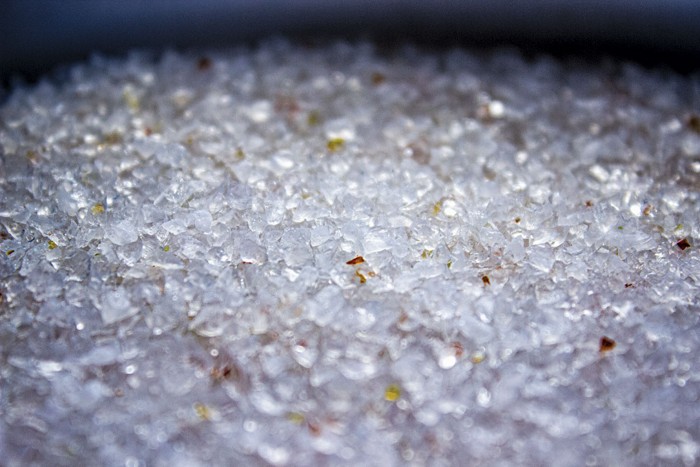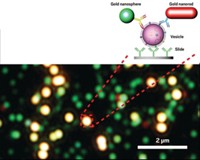Advertisement
Grab your lab coat. Let's get started
Welcome!
Welcome!
Create an account below to get 6 C&EN articles per month, receive newsletters and more - all free.
It seems this is your first time logging in online. Please enter the following information to continue.
As an ACS member you automatically get access to this site. All we need is few more details to create your reading experience.
Not you? Sign in with a different account.
Not you? Sign in with a different account.
ERROR 1
ERROR 1
ERROR 2
ERROR 2
ERROR 2
ERROR 2
ERROR 2
Password and Confirm password must match.
If you have an ACS member number, please enter it here so we can link this account to your membership. (optional)
ERROR 2
ACS values your privacy. By submitting your information, you are gaining access to C&EN and subscribing to our weekly newsletter. We use the information you provide to make your reading experience better, and we will never sell your data to third party members.
Consumer Products
What’s that Stuff
What is health-monitoring cat litter, and how does it help detect when your cat is sick?
Chemistry gives the classic adsorbent material a colorimetric twist and could provide information about your pet’s health
by Brianna Barbu
June 28, 2022
| A version of this story appeared in
Volume 100, Issue 24

If you have a cat, as approximately 25% of US households do according to the American Veterinary Medical Association, the internet may have shown you targeted ads for a health-monitoring cat litter. These products promise to change color in response to certain disease markers in a cat’s urine, to help owners spot early signs of illness before more serious symptoms arise.
“A goal with any disease is to pick up disease early, not late,” says Jody Lulich, who specializes in small-animal internal medicine at the University of Minnesota College of Veterinary Medicine. The earlier a disease can be caught, the better the outcome is likely to be.
Cats are relatively prone to urinary issues, especially as they get older or if they’re overweight, according to the Cornell Feline Health Center website. Naturally, given litter’s role absorbing pee, health-monitoring cat litters focus on detecting potential problems in a cat’s urinary tract: the kidneys, bladder, and the plumbing that connects them. But how do these litters do that? C&EN decided to try to get the scoop on it.
An absorbing topic
Unlike some other consumer products for monitoring a cat’s urinary health at home, such as urine-testing dipsticks, health-monitoring litters also need to work as an everyday cat litter. That means their main function is to absorb moisture and odors from your cat’s excretory activities, hopefully without kicking up too much dust.
Most cat litters—about 92%—are made from clay, according to Mariangela Imbrenda of the Clorox Company, the parent company of the Fresh Step litter brand. But indicator litters are made of silica, which is about 2% of the overall litter market. The other 6% covers the myriad organic litter materials, including corn, pine, paper, and even tofu.
Silica litter, often marketed as “crystal” litter, is made from amorphous silica gel, the same material that is often found in packets inside shoe boxes and bags of jerky to keep those products dry. Silica gel’s silicon-and-oxygen framework contains a multitude of tiny pores that adsorb small molecules that can form hydrogen bonds. For cat litter, those molecules are water and the ammonium ions that are produced when microbes break down urea in urine. Ammonium causes the acrid smell of a soiled litter box.
Silica litter doesn’t clump the way most clay litters do, and it’s more expensive, but it tends to be lighter, less dusty than clay, and more efficient at trapping moisture and odor-causing molecules: it can adsorb about 35% of its weight in water without swelling. Pure silica gel is also naturally white, which can help colors show up if dyes are added during the manufacturing process—for example, color-changing indicators to analyze a cat’s pee.
True colors

Colorimetric basics
A response to a chemical interaction is a key component of any chemical test, according to Jessica Beard, a chemistry PhD candidate at the Massachusetts Institute of Technology who is developing colorimetric tests for detecting water pollutants. In a colorimetric test, the response is a color change.
Colorimetric indicators are useful for tests where you don’t want to use sophisticated instrumentation, because they can be made so that the results are visible to the human eye, Beard says. And commercial indicators often rely on chemistries that have been known for a long time, which is a big plus, she adds. “If they could get it to work in the early 1900s, it’s probably tolerant of a lot of interference.”
Using colorimetric tests for a quick urine analysis is nothing new, veterinary expert Lulich says. Vets first test a pet’s urine using a dipstick test strip with colorimetric indicators before following up with more specific tests if necessary. These test strips may include tests for pH and the presence of certain disease markers such as protein, blood, or glucose.

The main feature that health-monitoring cat litters advertise is the ability to detect changes in pH using color. That’s exactly what C&EN saw when we got our paws on a bag of PrettyLitter indicator litter and tested its pH-indicating power. According to the company’s patent, PrettyLitter contains the indicator compound bromothymol blue. This compound is yellow in its protonated form (below pH 6) and blue in its deprotonated form (above pH 7.6). Solutions with a mix of protonated and deprotonated molecules appear as different shades of green.
In C&EN’s at-home tests, filtered water (approximately neutral pH) turned the litter a yellowish green, vinegar water (pH of around 3) created an orangey-yellow color, and baking soda in water (pH of about 8) turned the litter bright blue. The orange and yellow colors faded after a few hours, which Beard hypothesizes might be because of a proton transfer between the silica and the indicator. The blue did not fade.
Indicating a problem?
According to the Merck Veterinary Manual, the normal pH of cat urine is 6.3–6.6. It also says that urine pH can affect the formation of bladder stones, and some bacterial infections can result in alkaline urine. But according to Lulich, a cat’s urinary tract can handle quite a bit of variation in pH. “If the animal takes in a lot of alkali, the body is going to get rid of it,” he says. The same goes for consuming or making a lot of acid. “As long as the body can get rid of it, then it’s not abnormal.”
PrettyLitter Inc. did not respond to questions about the litter’s contents by C&EN’s deadline, but assuming the indicator is indeed bromothymol blue, PrettyLitter is probably alerting cat owners to urine below pH 6 and above pH 7.6. If the pH is outside that range, it could mean a cat is sick, but pH can also change for perfectly harmless reasons, Lulich says, because “pH is not very useful by itself.” Instead, vets will consider pH values in the context of other symptoms as well as risk factors such as a cat’s age, diet, and medical history.
Many health-monitoring litters are also supposed to detect blood in the urine. That could be a much more valuable test. Lulich says that blood in the urine can be a sign of a number of serious conditions. Almost any amount that’s detectable is concerning enough to follow up on, he says.
In the clinic, medical-grade urine test strips use diisopropylbenzene dihydroperoxide and 3,3′,5,5′-tetramethylbenzidine to detect blood. Blood contains hemoglobin, which contains iron(II). If any hemoglobin is present in the urine tested, the iron(II) will react with the peroxide molecules to form radicals. The radicals then oxidize the tetramethylbenzidine, triggering a color change from yellow to blue green.
But according to three brands, blood-detecting litter will turn red, not blue, if a cat’s pee has blood in it. With the help of American University chemist Matthew Hartings, C&EN tested PrettyLitter with a few different concentrations of hemoglobin in water (Hartings is a member of C&EN’s advisory board). C&EN found that the color of the litter reflected the color of the hemoglobin solution. So the blood detection, at least for PrettyLitter, seems to rely not on a chemical test but on the contrast of bloody urine’s reddish color against a white backdrop.
Although Lulich cautions against reading too much into single data points, he says he considers at-home pet health monitoring to be a generally positive thing because it can help foster communication between pet owners and vets, and that may lead to better health outcomes. “It doesn’t hurt anything but your pocketbook,” he says. “Anytime you can pick up disease early and not go overboard with tests that may hurt, then the answer is it should be good.”




Join the conversation
Contact the reporter
Submit a Letter to the Editor for publication
Engage with us on Twitter